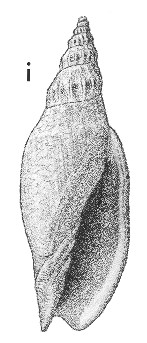
Revised descriptions of New Zealand Cenozoic Mollusca from Beu and Maxwell (1990)

 | Revised descriptions of New Zealand Cenozoic Mollusca from Beu and Maxwell (1990) | 
|
  (Pl. 49i): Castlecliff, Wanganui, Castlecliffian (GNS, from an early collection) |
Beu & Maxwell (1990): Chapter 16; p. 367; pl. 49 i.
Synonymy: Voluta fusus Quoy & Gaimard 1833, p. 627; Voluta gracilis Swainson 1835 (in 1834-1835), pt. 6, pl. 42 (not Voluta gracilis Dillwyn, 1823); Voluta subplicata Hutton 1873a, p. 18; Fulgoraria gracilis; Scaphella gracilis; Cymbiola gracilis; Fulgoraria (Alcithoe) hedleyi Murdoch & Suter, 1908, p. 288; Alcithoe fusus haurakiensis Dell 1956a, p. 54; Alcithoe (Leporemax) fusus, Beu & Maxwell 1990, p. 367, pl. 49i.
Type species of Leporemax Iredale, 1937
Classification: Volutidae: Zidoninae
Description: Small for genus (50-80 mm high), narrow and graceful, with long, almost parallel-sided last whorl, tapering very slightly to weakly defined neck, and wide, V-shaped anterior siphonal notch with rounded apex. Surface almost smooth, apart from low but obvious axial costae on spire whorls, raised into very low nodules on a weak angulation at base of weakly concave sutural ramp; nodules are medial on spire whorls but sculpture fades out before last whorl of most large shells. Aperture as in A. arabica, but collar never present on inner lip; 4 or 5 narrow plaits on columella. Protoconch small, 2-3 mm wide, otherwise as in A. arabica. Colour pattern of bright red-brown narrow zig-zag lines retained on some Castlecliffian fossils.
Comparison: In the modern fauna, Alcithoe fusus occurs as two weakly differentiated geographical forms that have been ranked by some authors as subspecies. The form occurring from about Hawke's Bay southwards has low, narrow axial costae; Dell (1956a, p. 54) pointed out that the type locality is Tasman Bay, Nelson. The form named hedleyi (Murdoch & Suter, 1908) (= A. fusus haurakiensis Dell, 1956) from the Bay of Plenty and Auckland-Northland has more prominent and more widely spaced axial costae than southern specimens. The narrowly cylindrical hedleyi form appears to be a deep-water ecomorph of A. fusus, and specimens from the inner to mid shelf intergrade. This has been demosntrated to be a single species, by molecular phylogeny (S. Hills, Massey University, pers. comm.). A. fusus resolutionis, from Five Fingers Peninsula, Dusky Sound, Fiordland, is Nukumaruan at youngest (Turnbull et al. 1985), and yet has still more reduced axial costae than Recent southern specimens of A. fusus. This suggests the possibility that weak sculpture is associated with low temperature in A. fusus, and populations lost or gained nodules in response to movement of isotherms during Pliocene and Pleistocene time. Carter (1972, p. 312) recognised a variant, "Leporemax fusus phenotype ruahiniensis n. var." (a name composed so as to be excluded from zoological nomenclature) from early Nukumaruan strata in Te Ekaou Stream, Pohangina, eastern Wanganui basin, that seems likely to be a weakly sculptured form of A. brevis. A. fusus has a similar protoconch to A. arabica, and also has direct development, so it is not surprising to find it is a highly variable species.
Distribution: Nukumaruan(?); Castlecliffian-Recent; Recent, New Zealand (types of Voluta fusus, Voluta gracilis, Voluta subplicata, Fulgoraria hedleyi, and Alcithoe fusus haurakiensis). Widespread around the main islands of New Zealand at present, on soft substrates in inner to outer shelf depths, but nowhere very common. A common fossil in offshore siltstone facies at Castlecliff, Wanganui (Castlecliffian) and less commonly found in late Nukumaruan siltstone in Wanganui basin, Hawke's Bay and Wairarapa, although the exact time range is unclear as A. fusus appears to intergrade very gradually with the apparently ancestral species A. brevis (Pl. 42n), which differs in its more prominent axial costae than those of A. fusus.
Cite this publication as: "A.G. Beu and J.I. Raine (2009). Revised
descriptions of New Zealand Cenozoic Mollusca from Beu and Maxwell (1990). GNS
Science miscellaneous series no. 27."
© GNS Science, 2009
ISBN
978-0-478-19705-1
ISSN 1177-2441
(Included with a PDF facsimile file
copy of New Zealand Geological Survey Paleontological Bulletin 58 in CD version
from: Publications Officer, GNS Science, P.O. Box 30368 Lower Hutt, New
Zealand)